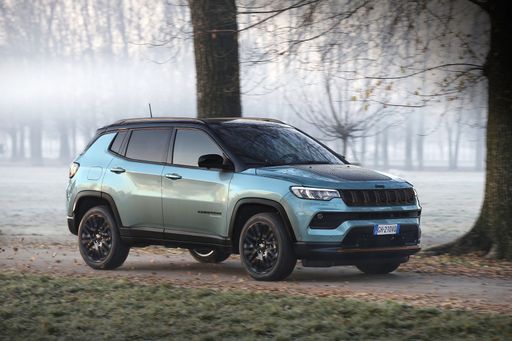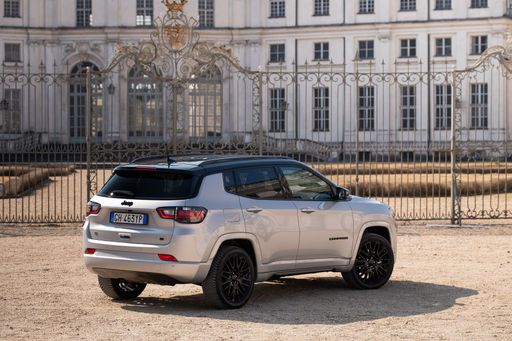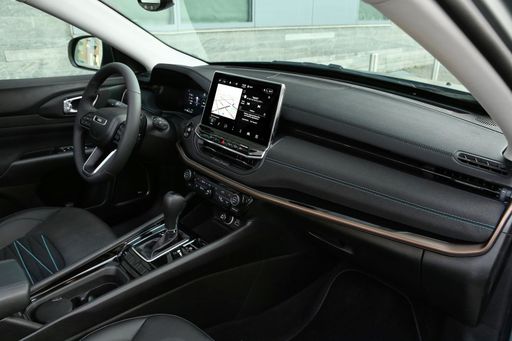Jeep Compass vs Nissan Qashqai – Which model is better for everyday use?
Compare performance, boot capacity, efficiency and price at a glance.
Find out which car is the better choice for you – Jeep Compass or Nissan Qashqai?
Costs and Efficiency:
Looking at overall running costs, both models reveal some interesting differences in everyday economy.
Nissan Qashqai has a a bit advantage in terms of price – it starts at 29600 £, while the Jeep Compass costs 34200 £. That’s a price difference of around 4595 £.
Fuel consumption also shows a difference: Nissan Qashqai manages with 4.50 L and is therefore distinct more efficient than the Jeep Compass with 5.80 L. The difference is about 1.30 L per 100 km.
Engine and Performance:
Power, torque and acceleration are the classic benchmarks for car enthusiasts – and here, some clear differences start to show.
When it comes to engine power, the Jeep Compass has a barely noticeable edge – offering 213 HP compared to 205 HP. That’s roughly 8 HP more horsepower.
In acceleration from 0 to 100 km/h, the Nissan Qashqai is a bit quicker – completing the sprint in 7.60 s, while the Jeep Compass takes 8.50 s. That’s about 0.90 s faster.
In terms of top speed, the Nissan Qashqai performs barely noticeable better – reaching 206 km/h, while the Jeep Compass tops out at 188 km/h. The difference is around 18 km/h.
There’s also a difference in torque: Jeep Compass pulls barely noticeable stronger with 345 Nm compared to 330 Nm. That’s about 15 Nm difference.
Space and Everyday Use:
Beyond pure performance, interior space and usability matter most in daily life. This is where you see which car is more practical and versatile.
Both vehicles offer seating for 5 people.
In curb weight, Nissan Qashqai is a bit lighter – 1420 kg compared to 1667 kg. The difference is around 247 kg.
In terms of boot space, the Jeep Compass offers barely noticeable more room – 550 L compared to 504 L. That’s a difference of about 46 L.
In maximum load capacity, the Jeep Compass performs minimal better – up to 1561 L, which is about 114 L more than the Nissan Qashqai.
Who wins the race?
The Nissan Qashqai proves to be wins the duel decisively and therefore becomes our DriveDuel Champion!
Nissan Qashqai is the better all-rounder in this comparison.
 @ Nissan Motor Corporation
@ Nissan Motor Corporation
Nissan Qashqai
Jeep Compass
The Jeep Compass packs classic Jeep styling with a surprisingly composed demeanor, equally at home turning heads in the city or tackling a weekend dirt track. Inside it's a pragmatic, user-friendly compact SUV that prioritizes comfort and versatility — a smart pick if you want a dose of adventure without giving up everyday sense.
details @ Jeep / Stellantis Media
@ Jeep / Stellantis Media
 @ Jeep / Stellantis Media
@ Jeep / Stellantis Media
 @ Jeep / Stellantis Media
@ Jeep / Stellantis Media
 @ Jeep / Stellantis Media
@ Jeep / Stellantis Media
 @ Jeep / Stellantis Media
@ Jeep / Stellantis Media
Nissan Qashqai
The Nissan Qashqai blends practical, family-friendly packaging with SUV styling that refuses to shout, making it a sensible and dependable choice for everyday life. It’s comfortable to live with, economical on the road, and neatly equipped enough to feel modern without ever feeling precious — perfect if you want crossover versatility without the drama.
details @ Nissan Motor Corporation
@ Nissan Motor Corporation
 @ Nissan Motor Corporation
@ Nissan Motor Corporation
 @ Nissan Motor Corporation
@ Nissan Motor Corporation
 @ Nissan Motor Corporation
@ Nissan Motor Corporation
 @ Nissan Motor Corporation
@ Nissan Motor Corporation
 @ Jeep / Stellantis Media
@ Jeep / Stellantis Media
|
 @ Nissan Motor Corporation
@ Nissan Motor Corporation
|
|
|
|
Costs and Consumption |
|
|---|---|
|
Price
34200 - 43200 £
|
Price
29600 - 39900 £
|
|
Consumption L/100km
5.8 - 5.9 L
|
Consumption L/100km
4.5 - 6.8 L
|
|
Consumption kWh/100km
17.50 kWh
|
Consumption kWh/100km
-
|
|
Electric Range
500 km
|
Electric Range
-
|
|
Battery Capacity
74 kWh
|
Battery Capacity
-
|
|
co2
0 - 133 g/km
|
co2
102 - 154 g/km
|
|
Fuel tank capacity
55 L
|
Fuel tank capacity
55 L
|
Dimensions and Body |
|
|---|---|
|
Body Type
SUV
|
Body Type
SUV
|
|
Seats
5
|
Seats
5
|
|
Doors
5
|
Doors
5
|
|
Curb weight
1667 - 2198 kg
|
Curb weight
1420 - 1665 kg
|
|
Trunk capacity
550 L
|
Trunk capacity
479 - 504 L
|
|
Length
4552 mm
|
Length
4425 mm
|
|
Width
1928 mm
|
Width
1835 mm
|
|
Height
1675 mm
|
Height
1625 mm
|
|
Max trunk capacity
1561 L
|
Max trunk capacity
1422 - 1447 L
|
|
Payload
-
|
Payload
466 - 520 kg
|
Engine and Performance |
|
|---|---|
|
Engine Type
Petrol MHEV, Electric
|
Engine Type
Petrol MHEV, Full Hybrid
|
|
Transmission
Automatic
|
Transmission
Manuel, Automatic
|
|
Transmission Detail
Dual-Clutch Automatic, Reduction Gearbox
|
Transmission Detail
Manual Gearbox, CVT, Reduction Gearbox
|
|
Drive Type
Front-Wheel Drive
|
Drive Type
Front-Wheel Drive, All-Wheel Drive
|
|
Power HP
145 - 213 HP
|
Power HP
140 - 205 HP
|
|
Acceleration 0-100km/h
8.5 - 10.3 s
|
Acceleration 0-100km/h
7.6 - 10.2 s
|
|
Max Speed
180 - 188 km/h
|
Max Speed
170 - 206 km/h
|
|
Torque
230 - 345 Nm
|
Torque
240 - 330 Nm
|
|
Number of Cylinders
3 - 4
|
Number of Cylinders
3 - 4
|
|
Power kW
107 - 157 kW
|
Power kW
103 - 151 kW
|
|
Engine capacity
1199 cm3
|
Engine capacity
1332 - 1498 cm3
|
General |
|
|---|---|
|
Model Year
2025
|
Model Year
2025
|
|
CO2 Efficiency Class
D, A
|
CO2 Efficiency Class
E, C
|
|
Brand
Jeep
|
Brand
Nissan
|
What drivetrain options does the Jeep Compass have?
The Jeep Compass is available as Front-Wheel Drive.
The prices and data displayed are estimates based on German list prices and may vary by country. This information is not legally binding.
